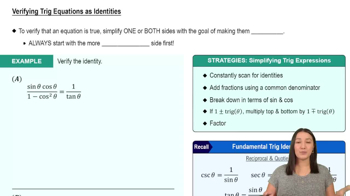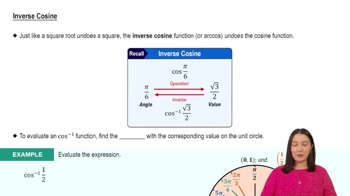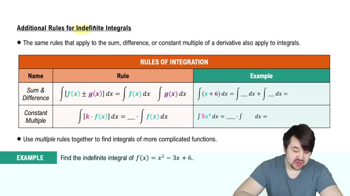Prove the following identities.
Table of contents
- 0. Functions7h 54m
- Introduction to Functions16m
- Piecewise Functions10m
- Properties of Functions9m
- Common Functions1h 8m
- Transformations5m
- Combining Functions27m
- Exponent rules32m
- Exponential Functions28m
- Logarithmic Functions24m
- Properties of Logarithms36m
- Exponential & Logarithmic Equations35m
- Introduction to Trigonometric Functions38m
- Graphs of Trigonometric Functions44m
- Trigonometric Identities47m
- Inverse Trigonometric Functions48m
- 1. Limits and Continuity2h 2m
- 2. Intro to Derivatives1h 33m
- 3. Techniques of Differentiation3h 18m
- 4. Applications of Derivatives2h 38m
- 5. Graphical Applications of Derivatives6h 2m
- 6. Derivatives of Inverse, Exponential, & Logarithmic Functions2h 37m
- 7. Antiderivatives & Indefinite Integrals1h 26m
- 8. Definite Integrals4h 44m
- 9. Graphical Applications of Integrals2h 27m
- 10. Physics Applications of Integrals 3h 16m
- 11. Integrals of Inverse, Exponential, & Logarithmic Functions2h 31m
- 12. Techniques of Integration7h 41m
- 13. Intro to Differential Equations2h 55m
- 14. Sequences & Series5h 36m
- 15. Power Series2h 19m
- 16. Parametric Equations & Polar Coordinates7h 58m
0. Functions
Trigonometric Identities
Problem 58a
Textbook Question
Apply the formula for cos (A − B) to the identity sin θ = cos (π/2 − θ) to obtain the addition formula for sin (A + B).
 Verified step by step guidance
Verified step by step guidance1
Start by recalling the identity for cosine of a difference: \( \cos(A - B) = \cos A \cos B + \sin A \sin B \).
Apply the identity \( \sin \theta = \cos(\frac{\pi}{2} - \theta) \) to the formula for \( \cos(A - B) \). Substitute \( A = \frac{\pi}{2} \) and \( B = \theta \) into the formula.
This substitution gives \( \cos(\frac{\pi}{2} - \theta) = \cos \frac{\pi}{2} \cos \theta + \sin \frac{\pi}{2} \sin \theta \).
Since \( \cos \frac{\pi}{2} = 0 \) and \( \sin \frac{\pi}{2} = 1 \), simplify the expression to \( \cos(\frac{\pi}{2} - \theta) = 0 \cdot \cos \theta + 1 \cdot \sin \theta = \sin \theta \).
Now, to find the addition formula for \( \sin(A + B) \), use the identity \( \sin \theta = \cos(\frac{\pi}{2} - \theta) \) and apply it to \( \sin(A + B) = \cos(\frac{\pi}{2} - (A + B)) \). Substitute \( A + B \) into the formula for \( \cos(A - B) \) to derive \( \sin(A + B) = \sin A \cos B + \cos A \sin B \).
 Verified video answer for a similar problem:
Verified video answer for a similar problem:This video solution was recommended by our tutors as helpful for the problem above
Video duration:
6mPlay a video:
Was this helpful?
Key Concepts
Here are the essential concepts you must grasp in order to answer the question correctly.
Trigonometric Identities
Trigonometric identities are equations that involve trigonometric functions and are true for all values of the variables involved. They are fundamental in simplifying expressions and solving equations in trigonometry. The identity sin θ = cos (π/2 − θ) is a co-function identity that relates sine and cosine, illustrating how these functions are interconnected.
Recommended video:

Verifying Trig Equations as Identities
Cosine of a Difference Formula
The cosine of a difference formula states that cos(A - B) = cosA cosB + sinA sinB. This formula is essential for deriving other trigonometric identities and is used to express the cosine of the difference of two angles in terms of the sines and cosines of those angles. It serves as a foundational tool in proving various trigonometric relationships.
Recommended video:

Inverse Cosine
Sine Addition Formula
The sine addition formula states that sin(A + B) = sinA cosB + cosA sinB. This formula allows us to express the sine of the sum of two angles in terms of the sines and cosines of the individual angles. It is crucial for solving problems involving the addition of angles and is derived using the cosine of a difference formula and other trigonometric identities.
Recommended video:

Additional Rules for Indefinite Integrals

 6:36m
6:36mWatch next
Master Simplifying Trig Expressions with a bite sized video explanation from Patrick
Start learningRelated Videos
Related Practice
Textbook Question
